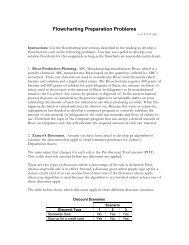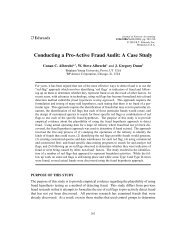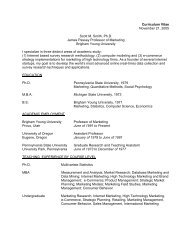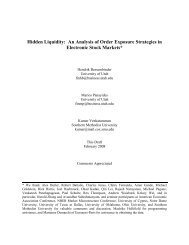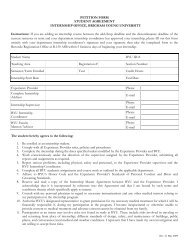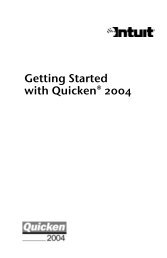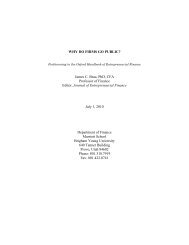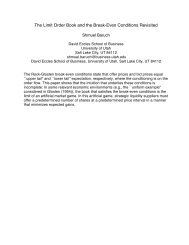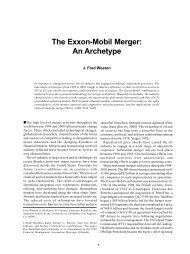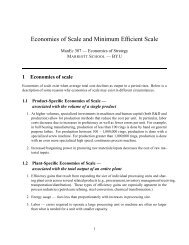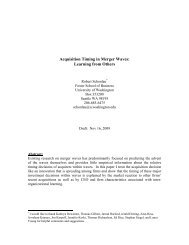Albrecht 19.pdf - Marriott School
Albrecht 19.pdf - Marriott School
Albrecht 19.pdf - Marriott School
You also want an ePaper? Increase the reach of your titles
YUMPU automatically turns print PDFs into web optimized ePapers that Google loves.
76154_23_ch19_p942-1006.qxd 3/1/07 3:35 PM Page 966<br />
966 Part 6 Control in a Management Accounting System<br />
The following examples show how each of the three alternatives increases ROI:<br />
1. Increase ROI by reducing expenses by $400,000, providing a segment operating<br />
profit of $1,400,000:<br />
$1,400,000<br />
<br />
$10,000,000<br />
<br />
14% 2 28%<br />
ROI<br />
2. Increase ROI by reducing average total assets to $4,000,000:<br />
$1,000,000<br />
<br />
$10,000,000<br />
<br />
$10,000,000<br />
<br />
$5,000,000<br />
$10,000,000<br />
<br />
$4,000,000<br />
10% 2.5 25%<br />
ROI<br />
3. Increase ROI by increasing revenue to $12,000,000 (assume that operating profit increases<br />
proportionately): 6 ROI<br />
$1,200,000<br />
<br />
$12,000,000<br />
$12,000,000<br />
<br />
$5,000,000<br />
residual income<br />
The amount of operating<br />
profit earned above a<br />
specified minimum rate of<br />
return on assets; used<br />
to evaluate investment<br />
centers.<br />
10% 2.4 24%<br />
Although ROI is an effective way of evaluating managers of investment centers, it has certain<br />
drawbacks. For example, assume that an investment center currently has an ROI of<br />
22%, but the company has an overall ROI of only 16%. If a new project or investment that<br />
promises a return of 19% becomes available to the investment center manager, it might<br />
be rejected because the investment center’s overall ROI would be reduced, even though<br />
the company’s overall ROI would be increased.<br />
Residual Income<br />
Although ROI is widely used to evaluate investment centers, because of its drawbacks,<br />
some companies use a closely related measure called residual income,<br />
which is the amount of operating profit an investment center is able to earn<br />
above a certain minimum rate of return on assets. The formula for residual income<br />
is as follows:<br />
Operating profit (Minimum required rate of return Average total assets) Residual income<br />
To illustrate, let’s return to Acme Computer and calculate its residual income.<br />
Assuming that the specified minimum rate of return on assets at IMC is 15%, Acme<br />
Computer needs to earn at least $750,000 (15% $5,000,000 average total assets) before<br />
it can report any residual income. We then compute Acme Computer’s residual income<br />
as follows:<br />
$1,000,000 segment margin $750,000 minimum return on assets $250,000 residual income<br />
To further illustrate why many companies prefer to use residual income over ROI for<br />
evaluating investment center performance, assume that Acme Computer has an opportunity<br />
to invest $1,200,000 in a new project that will generate a return of 16% ($192,000<br />
per year). If Acme Computer’s manager is being evaluated on ROI, she would probably<br />
reject this investment opportunity because, as the following analysis shows, it would reduce<br />
the division’s overall ROI from 20% to 19.2%.<br />
6 As will be discussed in Chapter 20, operating profit is likely to increase more than proportionately when revenue rises.<br />
Because some costs (such as rent) are fixed in amount, operating profit should increase to more than 10% when revenue increases<br />
10%. As a result, the ROI in this example should actually increase to more than 24%.



